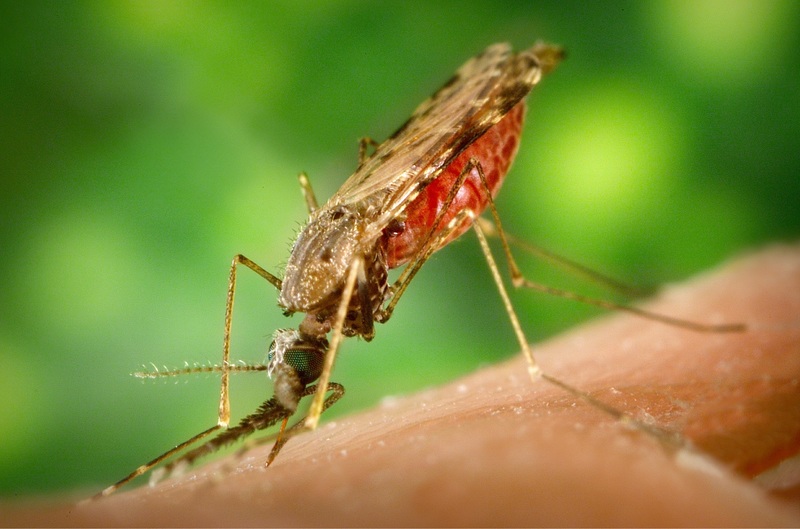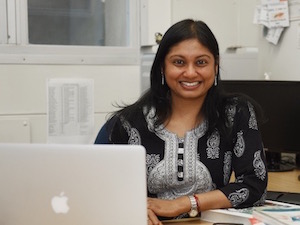Plotting enemy movements: Sheetal Silal’s powerful contribution to eliminating malaria
16 May 2017 | Natalie Simon. Profile image of Sheetal Silal by Robyn Walker.
It is a scene in just about every war movie: the generals stand around a table moving miniature armies on a map. They are locked in a deadly battle. They need to predict the movements of the enemy troops accurately so they can cut them down with minimum fatalities to their own side. The stakes are high – a miscalculation can result in the deaths of thousands.
She may not be dressed in military fatigues, and she may not be working from a tent on a battlefield, but this is effectively what Dr Sheetal Silal does everyday. Her enemy is malaria. Her secret weapon is mathematical modelling.
Mathematical modelling of malaria
“This is a deadly serious battle we are facing,”
“This is a deadly serious battle we are facing,” says Silal, senior lecturer in the Department of Statistical Sciences,. According to the World Health Organisation (WHO), nearly half the world’s population is at risk of malaria, with an estimated half a million deaths from the disease in 2015. To help achieve the global goal to eliminate malaria by 2030, Silal builds simulations that show how the disease spreads in order to help policymakers control and fight the disease.
In order to stop a disease you need to understand its biology and how it spreads, explains Silal. To use malaria as an example, not everyone who has malaria feels ill. Many carriers are asymptomatic and have no idea that they are spreading the disease.
“This iceberg scenario, observing only a small proportion of cases, poses a major challenge to policymakers trying to battle a disease. It means that the infectious reservoir is almost always out of reach because you’re not going to seek treatment if you don’t feel sick.”
This is where mathematical modelling can help, because it seeks to predict and plot out the behaviour and spread of these infectious diseases. With this information, policymakers can then be proactive about which populations to target, who to vaccinate, when to vaccinate and other proactive measures to pre-empt the situation, and/or react effectively.
This is revolutionary.
“Twenty years ago this would never have been possible: it would have been the stuff of science fiction,” she says. “But today, through science and technological advancements, mathematical modelling of diseases plays an integral part in shaping policy and saving lives.”

Statistical Sciences was the first researcher to model
malaria in South Africa.
The path to mathematical modelling
This modelling brings together a few disciplines, explains Silal. Firstly you require a good understanding of biology, in order to explain how the disease behaves in your body. Then you need to be able to work with large amounts of data on previous epidemics and the population of interest, which means that statistics comes into play and you need mathematics to create equations from all this information. Finally, you use computer science to write a program that brings it all together to create a model.
Silal herself first dipped her toes into disease modelling as part of her master’s degree. Her postgraduate work was in operations research, and one of the modules she took was called system dynamics.
“This was about understanding and modelling systems: the theory could be applied to any system. Whether in production lines or a disease, systems are everywhere,” she says.
Then an opportunity came up to work with her supervisor on statistical analysis of malaria, and they thought it might be interesting to try and model the disease using what she learned in system dynamics.
“So I read a few papers and started programming a few models and absolutely fell in love with it,” she says. “It has been a decade and I am still working on malaria modelling.” In fact, she built the first mathematical model for malaria in South Africa.
Ridding the planet of malaria
What keeps her in it, she says, is knowing that she is making a tangible difference in the lives of everyday people.
She is integrally involved in the worldwide iniative to rid the planet of malaria. One of the projects she is working on at present is to plan an elimination strategy for the Asia Pacific. She has just completed a modelling exercise to determine cost-effective strategies to advise governments on what may or may not work. Her models have been developed into a web application to assist national malaria control programmes in their decision making.
“This has been a real highlight for me,” she says, “I believe one of the biggest achievements you can have as a researcher is to see your research translated into policy.”
Training more mathematical modellers to tackle disease
Mathematical modellers are rare creatures, not only in Africa, but around the world. Another of Silal’s goals is therefore to train more scientists to be able to model disease in this way. To this end she runs an annual short course at UCT to train more modellers. These courses attract not only postgraduate researchers but also individuals from public, private and NGO sectors who are actively involved in the initiative to eliminate malaria.
Silal says she cannot stress enough the powerful role mathematics can play in the battle against infectious diseases.
“Mathematics may not be the traditional answer when you talk about combating disease,” she says. “But mathematical modeling has become an integral tool in supporting policy. I would encourage students not to shy away from mathematics, statistics and computer science. Put together, these three subjects make a very powerful package to change the world.”
 This work is licensed under a Creative Commons Attribution-NoDerivatives 4.0 International License.
This work is licensed under a Creative Commons Attribution-NoDerivatives 4.0 International License.
Please view the republishing articles page for more information.
Research & innovation





































